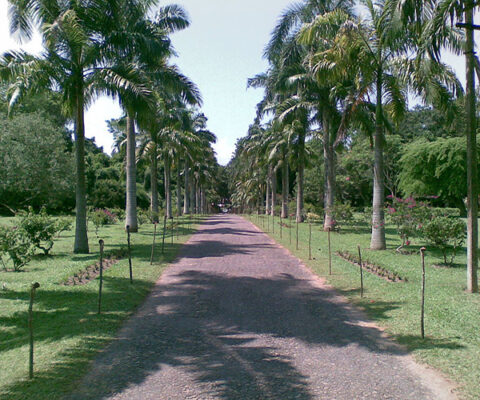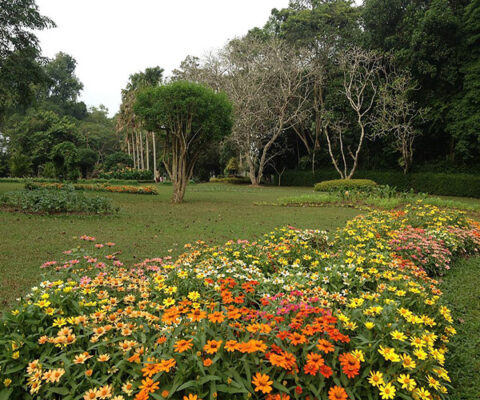Henarathgoda Botanical Gardens – evolution of Sri Lankan economy
By Arundathie Abeysinghe
 Situated in close proximity to Gampaha town and Gampaha Railway Station in Gampaha -Minuwangoda Road about 32 kilometers from Colombo, Henarathgoda Botanical Gardens also known as Gampaha Botanical Gardens was opened in 1876.
Situated in close proximity to Gampaha town and Gampaha Railway Station in Gampaha -Minuwangoda Road about 32 kilometers from Colombo, Henarathgoda Botanical Gardens also known as Gampaha Botanical Gardens was opened in 1876.
Surrounded by paddy fields, the picturesque water stream (Attangalu Oya) and a secondary forest, the Gardens has a large collection of tropical flower plants, an extensive collection of palms, orchids, endemic trees, properly designed shrubs, bushes and trees as well as a well-landscaped garden layout. Plants from every corner of Sri Lanka can be found in the Gardens. The Gardens is linked to the evolution of Sri Lankan economy as the first imported rubber tree to Sri Lanka was first planted in the Gardens from the first imported seedlings of Brazilian rubber tree (Hevea brasiliensis) planted in Asia. According to legends, British Explorer Sir Henry Alexander Wickham had smuggled the rubber seeds from Santarém, Pará, Brazil and imported them to *Ceylon from Royal Botanical Gardens, Kew.
Henarathgoda Botanical Gardens was established by the British during the British Colonial Era to conduct experiments on exotic economically viable plants such as rubber as well as to explore plant wealth and development of the economy of Ceylon. The project of rubber plantation had been handed over to Muhandiram A. de Zoysa, the first curator of the Gardens. The British naturalists conducted experiments on rubber plantation in Ceylon due to the failure of rubber cultivation experiments in India. During experiments conducted in Ceylon, the British naturalists discovered that Ceylon had similar environmental conditions of Amazon. As the first rubber plants blossomed throughout the country in 1880, the seedlings were distributed and planted in different parts of the country, leading to a flourishing rubber plantation industry.

Later, the Botanical Gardens had been developed as a botanical garden adding new plants and sections. As such, there are trees, plants as well as flowers from almost every tropical country in the Gardens. The original extent of the Gardens had been 36 acres and later additional seven acres had been added in 2005.
Henarathgoda Botanical Gardens is a tropical low country botanical garden and with the establishment of Department of National Botanical Gardens in 2006, the Gardens functions as a division of the Department.
Apart from scenic attractions, botanical plants, flowers and trees, the Gardens is home to 80 bird species including 10 endemic species, 18 species of mammals including Sri Lankan Flying Squirrel (Petaurista philippensis – known as hambawa in Sinhala), 12 species of butterflies and 10 species of dragonflies.
The Gardens has an orchid garden (with a rare specimen – Queen of Orchids – Cattleya), a Japanese Garden, a medicinal plants section with a collection of plants (such as arrow poison from Africa and Malaya such as Antiaristoxicaria), a forest path and an educational garden. Hence, the Botanical Garden is of utmost importance to scholars experimenting on trees and plants, naturalists, environmentalists, botanists, undergraduates as well as school children.
The Botanical Gardens also serves as a site for conservation of Sri Lanka’s floriculture and a center for botanical research.
The majority of trees planted in the 19th century when the Garden was established are preserved to date. The remnants of the first rubber tree which collapsed due to heavy rains and storms in 1988 are protected as a national monument.
At present, there is a separate area in the Gardens where visitors can take boat rides in Attangalu Oya. There is a bridge over Attangalu Oya where visitors can enjoy the cool breeze and admire the breathtaking scenery.

The Botanical gardens is opened throughout the year. But the best period to visit it is immediately after monsoon season when the foliage is brimming with vibrancy with flowers in full bloom.
- Ceylon – Sri Lanka gained Independence from British Colonials in 1948. In 1972, Ceylon became a republic within the Commonwealth and Ceylon was thereafter known as Sri Lanka.







